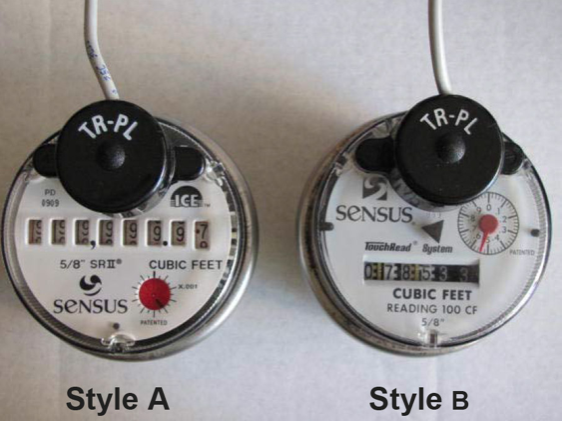To read your meter, follow these simple steps:
- Locate Your Meter
The water meter is usually located near the curb in front of the house or place of business. It is in the ground housed in a concrete box marked WATER. Carefully remove the meter box lid using a tool such as a screwdriver. The meters have wires attached to the lid for the antenna. Remove the lid slowly and gently to avoid breaking the wires. Visually examine the area around the meter to ensure your safety. (Black widow spiders are known to nest in meter boxes.) - Read Your Meter
Reading a water meter is similar to reading an automobile odometer. There are two styles of TouchRead meters. Style A has an eight-digit number on the face. Style B has a six-digit number on the face called the readout (see illustration below). This shows the total number of units used, as well as partial units.
Example Style A: 0,002,124.3
The reading is 2 unitsExample Style B: 0785.3354
The reading is 785 units
- Figure Your Water Use
To calculate your water use, pick a starting point at which to read your meter. Record the reading and date. Read the meter 24 hours later. Subtract the first reading from the second, this will give you your usage in hundred cubic feet or units. Each unit is equal to 748 gallons. Multiply by sixty (60 days per billing period) to approximate your water usage for one billing period.
For Example:
Second Reading - 1618.6721
First Reading - 1618.5421
Total Units - 013 x 60 = 7.8 units
Total Gallons - 5,834
Note: The Westborough Water District charges for water by the unit (100 cubic feet or HCF). Each unit (HCF) consists of 748 gallons. - Monitor Your Water Use
Read your meter on a regular basis to track your water use and keep a record of all readings. You will be able to detect trends from season to season and year to year. If your household changes in any way that affects water use (e.g., new family member, plumbing upgrade, etc.), you will be able to determine the change. - Check for Household Leaks
The little triangle or red wheel on the face of the meter is a low flow indicator. It will rotate with even a very low flow through the meter (i.e., leaky toilet or irrigation valve). To check for leaks, turn off all known water uses inside and outside the house. If you have an automatic icemaker, make sure it is not operating. When all water is turned off, the low flow indicator should not move. If the low flow indicator is moving, there is water flowing somewhere on your property. Try turning off the house shut-off valve (usually located where the water line enters the house). If the low flow indicator continues moving with the house valve off, water is flowing outside the house (most likely the irrigation system). If the low flow indicator stops moving with the house valve off, water was flowing inside the house. (This could be a toilet leak, a leaky pipe, or any number of problems.) When you have finished reading the meter, carefully replace the meter box lid.
How Much Water is Used?
Inside the home:
| Running the tap | 1.5-6 gallons per minute |
| Taking a shower | 2-7 gallons per minute |
| Taking a bath | 20-60 gallons per bath |
| Washing a full load of clothes | 15-60 gallons per load |
| Flushing the toilet | 1.28-7 gallons per flush |
| Running an automatic dishwasher | 11-14 gallons per load |
Outside the home:
| Running the hose | 5-10 gallons per minute |
| Watering 1,000 ft2 of grass | 850 gallons per week (summer) |
| Watering 1,000 ft2 of grass | 400 gallons per week (fall) |
| Watering 1,000 ft2 of shrubs | 450 gallons per week (summer) |
| Watering 1,000 ft2 of shrubs | 200 gallons per week (fall) |
| Watering a mature fruit tree (15’ canopy) | 131 gallons per week (summer) |
| Watering a mature fruit tree (15’ canopy) | 41 gallons per week (fall) |